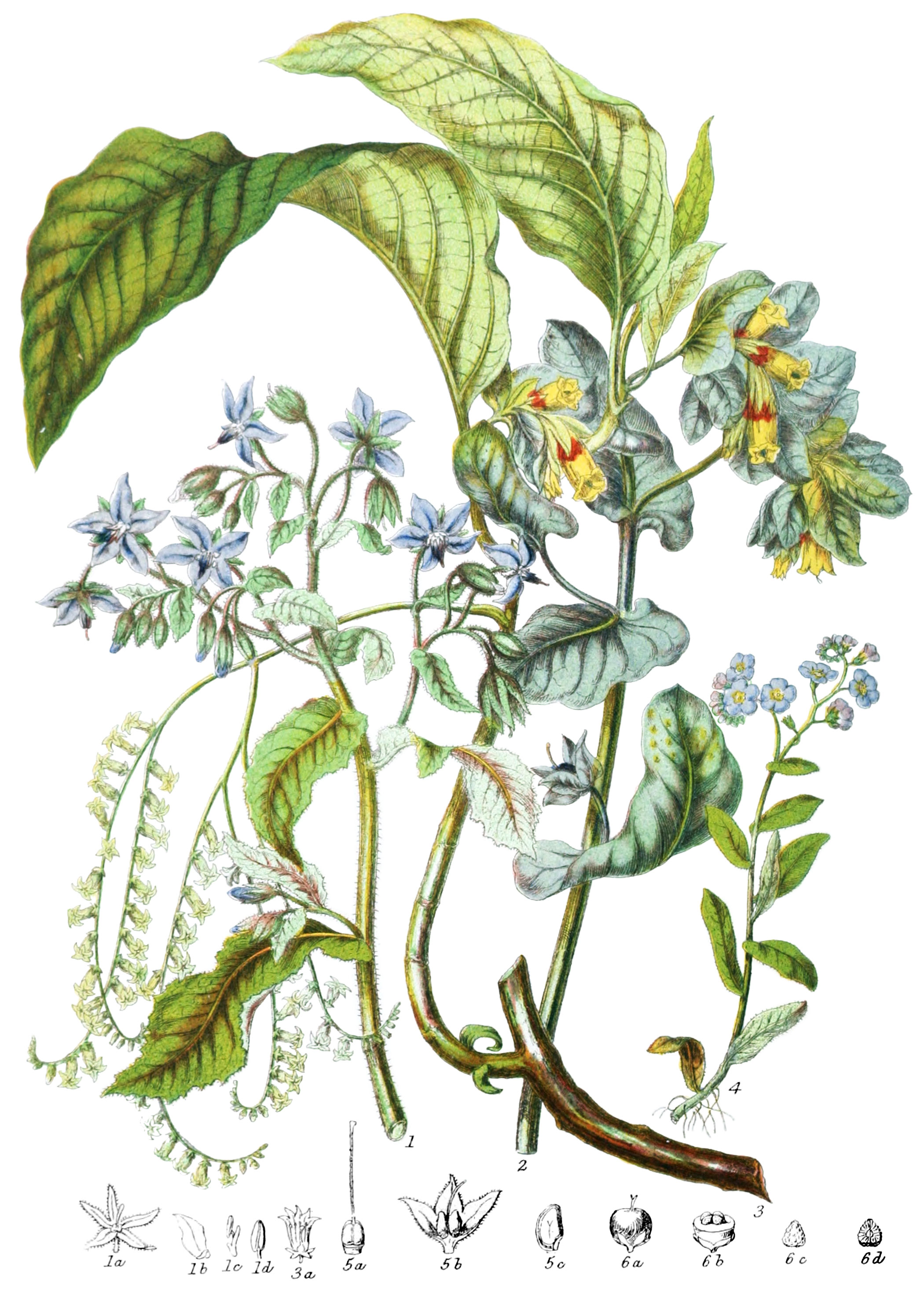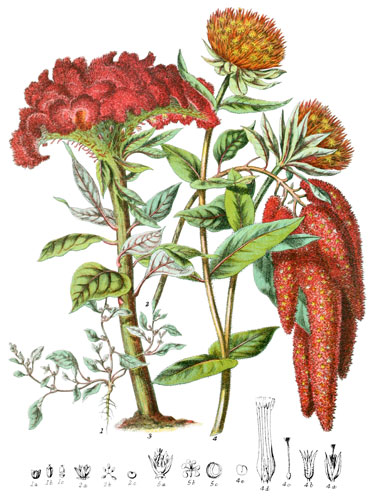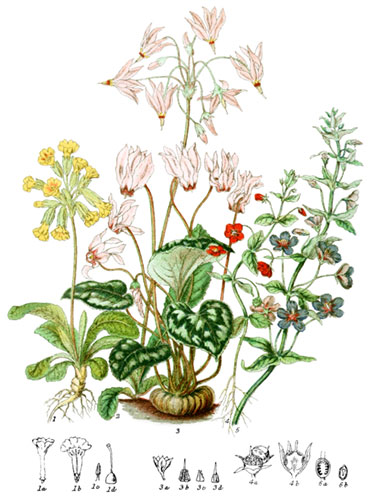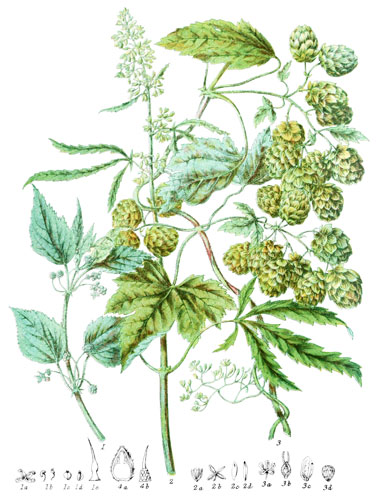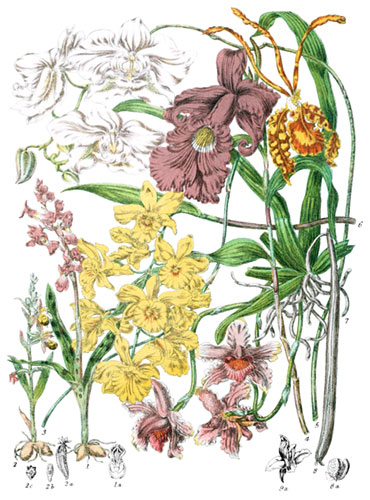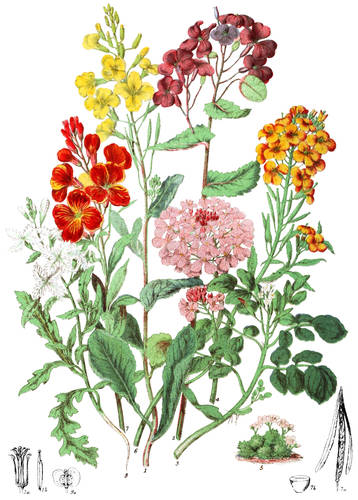Key characteristics
Trees, shrubs, and herbaceous plants, with round stems. The leaves are alternate, simple, often covered with rough hairs growing out of a hard base; without stipules. The flowers grow on one-sided spikes, or racemes, or panicles, sometimes solitary from the base of the leaf-stalk. The calyx has four or five divisions, and is persistent. The corolla is of one petal attached ot the base of the ovary, tubular, the upper part divided into as many segments as the calyx. The stamens are inserted on the corolla, are equal in number with the segments, and alternate with them. The ovary is four-parted, and four -seeded; or two-parted and four-celled. The style is ismple arising from the base of the lobes of the ovary in Borago and others, termino in Heliotropium and Tournefortia; the stigma is simple or bifid. The seeds are distinct, four or two, separable from their covering, destitute of albumen. Those of Tournefortia are connected in a berry, and contain a small portion of albumen.
This Tribe is closely allied to the Nettle tribe, but has a regular corolla, a round not a square stem, and rough leaves without resinous dots.
These plants contain mucilaginous cooling properties.
Select plants in this order
Not all plants listed are illustrated and not all plants illustrated are listed.
- Borago was known to Pliny as a cheering addition to wine; the flowers of B. officinalis (1) were long after his time used as an ingredient in a cooling, refreshing beverage. It has a tapering mucilaginous root, and large succulent stalks, which, as well as the leaves, are thickly beset with sharp bristles. Like all the plants of this tribe, the flower-stalk is incurved until the buds open, and the petals of this genus and many others are pink in the bud, and only acquire their bright azure hue when fully expanded. This is one of the curious facts respecting the colouring of flowers requiring the combined study of chemist and botanist.
- B. orientalis is a native of Turkey; B. crassifolia of Persia.
- Cerinthe (2) is common in France, and there called Melinet; in England, Honey-wort, from the store it offers to bees. In Italy and Sicily it grows plentifully.
- Myosotis (4) is one of the fairst ornaments of our rivulets, and has been named Forget-me-not here and in Germany, and considered an emblem of frendship. The pink buds change to a pure enamelled blue when open. Other species grow in woods, fields, and other dry situations.
- M. versicolor has yellow flowers mingled with the blue.
- M. azorica, brought by Mr. H. C. Watson from the Azores, is larger and of a deeper blue than any of our British species.
- Several other genera of this tribe belong to our flora.
- Anchusa officinalis, the Alkanet of old authors, was formerly supposed to possess cordial properties; it is chiefly to be seen near the sea in Northumberland.
- Cynoglossum, the Hound’s-tongue of waste ground and roadsides, has a pungent, nauseous scent, and is esteemed narcotic.
- Amongst the flowers which come forth in May is Pulmonaria; the leaves, once supposed to be efficacious for coughs, are speckled with white.
- The fleshy mucilaginous roots of Symphytum officinale had also formerly a reputation for coughs; it grows generally in watery places, as in a hedge ditch; once plentiful near the Thames in the meadows of Twickenham.
- S. tuberosa, with its large white roots, belongs more to the south of Scotland than to England; it is found likewise in the woods and mountains of Germany.
- Echium vulgare, the Viper’s-Bugloss, is clothed in all parts with the prickly bristles arising from the callous points; notwithstanding its roughness, it is a fine plant when the long spike of red buds, and the blue flowers, have attained the height of one or two feet. On some of the old walls in the north of France it grows much taller, and is very beautiful.
- E. rubrum yields a red substance, useful to dyers.
- Lithospermum is distinguished by the grey polished seeds, as hard as stones; it is sometimes called Grey Millet, from the appearance of the seeds. The bristles of this genus are minute and hard; the flowers blue or buff.
- L. arvense, growing principally in corn-fields, has white flowers. The red coating of the roots serves as a red dye, but that of L. tinctoria is more used.
- Onosmodium is one of the few species in N. America; Trichodesma, of Northern India, where it is used to cure the bite of snakes.
- Tournefortia, named by Linnæus after the great French botanist, belongs to the section of this tribe with the seeds united in a berry, preserving the two chief characters of rough leaves and incurved flower-stalks.
- T. argentea bears a pretty cluster of white berries.
- T. cymosa (3) has an extremely graceful aspect when the slender cymes of pale flowers hang from amidst the large leaves.
- Some species of Ehretia (6)* bear eatable berries.
- The favourite flower of this section is the fragrant Heliotrope.
- Heliotropium europæum has been cultivated three hundred years.
- H. peruvianum was brought from Peru about a century ago; it has larger clusters of flowers, and is more highly scented.
- H. europæum is one of these plants found on the plains of India.
- H. malabaricum is peculiar to that country.
- Anchusa, Myosotis, and some other European genera, exist also in the Himalays.
Locations
This Tribe inhabits chiefly the Temperate countries of the Northern Hemisphere, is very abundant in South Europe and Central Asia, diminishing northwards. Heliotropium, Tournefortia, and others are principally Tropical trees or shrubs; a few only extending to South Europe, or in America as far as 45° north.
Legend
- Borago officinalis, Common Borage. England.
- Calyx.
- Petal.
- Stamen.
- Anther.
- Cerinthe major, Great Honey-wort. South of France.
- Tournefortia cymosa, Broad-leaved Tournefortia. Jamaica.
- Flower.
- Myosotis palustris, Forget-me-not. Streams, England.
-
- Pistil of Symphytum.
- Calyx with two Nuts.
- Section of Seed.
-
- Fruit of Ehretia.
- Section of Fruit.
- Seed.
- Section.
*6 was mentioned in the original description but only 4a–4d were illustrated.
Explore more
Posters
Decorate your walls with colorful detailed posters based on Elizabeth Twining’s beautiful two-volume set from 1868.
Puzzles
Challenge yourself or someone else to assemble a puzzle of all 160 botanical illustrations.
